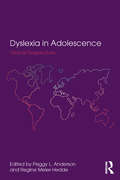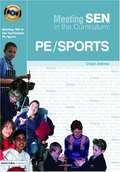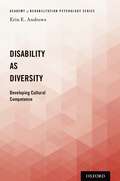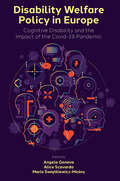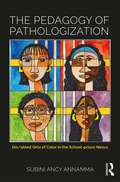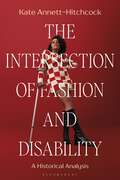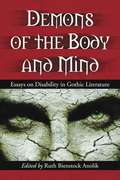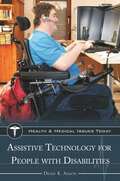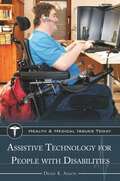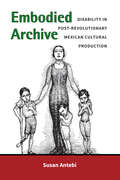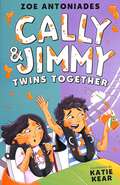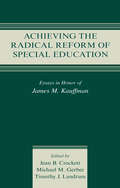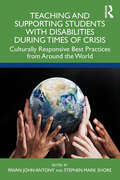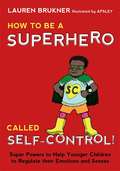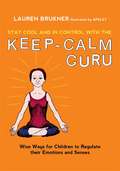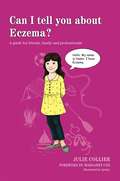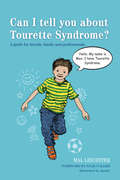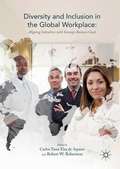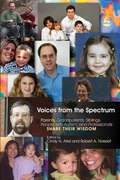- Table View
- List View
Dyslexia in Adolescence: Global Perspectives
by Peggy L. Anderson Regine Meier-HeddeDyslexia in Adolescence: Global Perspectives presents international case studies on the psychosocial development and academic progress of adolescents with dyslexia to enhance understanding of adjustment factors, outcomes and support. The continuation of a qualitative longitudinal research project that focused on children between ten and twelve years of age, this volume revisits them between ages fourteen and sixteen. Through semi-structured interviews, personal narratives, and other assessments, these case studies relate the trials and tribulations associated with the development of adolescents with dyslexia from around the world and the challenges that parents face in supporting their children.
Dyslexia in Adolescence: Global Perspectives
by Peggy L. Anderson Regine Meier-HeddeDyslexia in Adolescence: Global Perspectives presents international case studies on the psychosocial development and academic progress of adolescents with dyslexia to enhance understanding of adjustment factors, outcomes and support. The continuation of a qualitative longitudinal research project that focused on children between ten and twelve years of age, this volume revisits them between ages fourteen and sixteen. Through semi-structured interviews, personal narratives, and other assessments, these case studies relate the trials and tribulations associated with the development of adolescents with dyslexia from around the world and the challenges that parents face in supporting their children.
Meeting SEN in the Curriculum: PE and Sports
by Crispin AndrewsMeeting the needs of pupils with SEN on the sports field and in the gym or swimming pool can be very challenging for non-specialist teachers-they need help. This book describes strategies which are practical and effective in mainstream settings. Case studies exmplify good practice in situations involving pupils with a wide range of special needs- from physical difficulties (what does a wheel-chair user do while everyone else plays rugby?) - to communication difficulties and cognitive problems.
Disability as Diversity: Developing Cultural Competence (Academy of Rehabilitation Psychology)
by Erin E. AndrewsDisability as Diversity: Developing Cultural Competence reveals why disability is a cultural experience, rather than merely a medical status. Conceptual models of disability have evolved into a complex biopsychosocial phenomenon that disability service providers must understand to fully appreciate the intricacy of the lives of the people they serve. In this volume, Andrews sets the stage with the must-know history of disability rights and the social and cultural evolution of disabled people in the United States. She presents important concepts about attitudes toward disability and the impact of ableism. Andrews illustrates that not only are negative attitudes harmful, but that overly positive stereotypes can have an equally detrimental effect on disabled people. The reader will learn about disability microaggressions and how attempts to improve disability awareness can be misguided. Andrews argues that there is a distinct disability culture, and introduces the reader to its characteristics and features. She explores the concept of disability identity development, and how some people with disabilities identify readily as disabled and embrace the disability community, while others do not view themselves as disabled even though they meet commonly accepted criteria for disability. Andrews delves into the intricacies and controversies of disability language, including person-first and identity-first language. The reader will gain enhanced knowledge and skills to provide culturally competent care to individuals, as well as methods to enrich cultural humility at the organizational level. Andrews offers readers a guide to disability-related considerations for psychological testing and assessment and the role of universal design. Readers will learn about specific considerations for intervention with children and adults with disabilities, including how to tailor intervention approaches, clinician attitudes, and the use of evidence based treatments. Researchers will find a thorough exploration of the challenges inherent in disability research, the importance of full consumer inclusion, and future directions to reduce health disparities based on disability. This book offers practical suggestions for clinicians and researchers who work with people with disabilities in order to be culturally effective in all aspects of assessment, intervention, and scientific inquiry.
Disability as Diversity: Developing Cultural Competence (Academy of Rehabilitation Psychology)
by Erin E. AndrewsDisability as Diversity: Developing Cultural Competence reveals why disability is a cultural experience, rather than merely a medical status. Conceptual models of disability have evolved into a complex biopsychosocial phenomenon that disability service providers must understand to fully appreciate the intricacy of the lives of the people they serve. In this volume, Andrews sets the stage with the must-know history of disability rights and the social and cultural evolution of disabled people in the United States. She presents important concepts about attitudes toward disability and the impact of ableism. Andrews illustrates that not only are negative attitudes harmful, but that overly positive stereotypes can have an equally detrimental effect on disabled people. The reader will learn about disability microaggressions and how attempts to improve disability awareness can be misguided. Andrews argues that there is a distinct disability culture, and introduces the reader to its characteristics and features. She explores the concept of disability identity development, and how some people with disabilities identify readily as disabled and embrace the disability community, while others do not view themselves as disabled even though they meet commonly accepted criteria for disability. Andrews delves into the intricacies and controversies of disability language, including person-first and identity-first language. The reader will gain enhanced knowledge and skills to provide culturally competent care to individuals, as well as methods to enrich cultural humility at the organizational level. Andrews offers readers a guide to disability-related considerations for psychological testing and assessment and the role of universal design. Readers will learn about specific considerations for intervention with children and adults with disabilities, including how to tailor intervention approaches, clinician attitudes, and the use of evidence based treatments. Researchers will find a thorough exploration of the challenges inherent in disability research, the importance of full consumer inclusion, and future directions to reduce health disparities based on disability. This book offers practical suggestions for clinicians and researchers who work with people with disabilities in order to be culturally effective in all aspects of assessment, intervention, and scientific inquiry.
Disability Welfare Policy in Europe: Cognitive Disability and the Impact of the Covid-19 Pandemic
by Angela Genova, Alice Scavarda, Maria Swiatkiewicz-MosnyDisability Welfare Policy in Europe:Cognitive Disability and the Impact of the Covid-19 Pandemic analyses the impact of the Covid-19 pandemic on persons with cognitive disabilities and their families. Written from a Disability Studies perspective, this edited collection investigates education, employment, social and health care services in European case studies. Recognising how Covid-19 health surveillance has limited the rights of all persons, the chapters demonstrate how its impact has been even more severe on persons with cognitive disabilities and their families. Outlining the changes in welfare services during the Covid-19 pandemic that have led to new forms of segregation and hindered full participation of persons with disabilities in society on an equal basis with others, the collection chronicles a setback in the process of implementing the UN Convention for the Rights of Persons with Disabilities (UNCRPD). Within the framework of public sociology, Disability Welfare Policy in Europe:Cognitive Disability and the Impact of the Covid-19 Pandemic shows the failure of the attempts aimed at shifting disability policy into the mainstream. The authors highlight how persons with disabilities, their families, as well as personnel working in disability welfare policy have fought to keep the perspectives and rights of persons with disabilities on the policy agenda. If the Covid-19 health surveillance has rendered persons with disabilities invisible, how can they be made visible once again?
The Pedagogy of Pathologization: Dis/abled Girls of Color in the School-prison Nexus
by Subini Ancy AnnammaWINNER OF THE 2018 NATIONAL WOMEN'S STUDIES ASSOCIATION ALISON PIEPMEIER BOOK PRIZE Linking powerful first-person narratives with structural analysis, The Pedagogy of Pathologization explores the construction of criminal identities in schools via the intersections of race, disability, and gender. amid the prevalence of targeted mass incarceration. Focusing uniquely on the pathologization of female students of color, whose voices are frequently engulfed by labels of deviance and disability, a distinct and underrepresented experience of the school-to-prison pipeline is detailed through original qualitative methods rooted in authentic narratives. The book’s DisCrit framework, grounded in interdisciplinary research, draws on scholarship from critical race theory, disability studies, education, women’s and girl’s studies, legal studies, and more.
The Pedagogy of Pathologization: Dis/abled Girls of Color in the School-prison Nexus
by Subini Ancy AnnammaWINNER OF THE 2018 NATIONAL WOMEN'S STUDIES ASSOCIATION ALISON PIEPMEIER BOOK PRIZE Linking powerful first-person narratives with structural analysis, The Pedagogy of Pathologization explores the construction of criminal identities in schools via the intersections of race, disability, and gender. amid the prevalence of targeted mass incarceration. Focusing uniquely on the pathologization of female students of color, whose voices are frequently engulfed by labels of deviance and disability, a distinct and underrepresented experience of the school-to-prison pipeline is detailed through original qualitative methods rooted in authentic narratives. The book’s DisCrit framework, grounded in interdisciplinary research, draws on scholarship from critical race theory, disability studies, education, women’s and girl’s studies, legal studies, and more.
The Intersection of Fashion and Disability: A Historical Analysis
by Kate Annett-HitchcockThe history of the fashion industry has been well written as it relates to people who conform to certain physical norms and cultural stereotypes, whereas the inequality in access to the world of fashion has been largely ignored. Despite this lack of coverage, much work has taken place over the centuries to enable people who live with disability to participate in fashionable culture. This book tells that story via perspectives of notable historical figures, events and movements, and continues the discourse with a look at some of the contemporary developments in clothing and fashion.The Intersection of Fashion and Disability takes the long view, from early attempts to conceal 'unsightly' bodies of royalty and nobility via creative innovation through growing contemporary awareness of inclusive fashion and how future work can be driven by technology and cultural acceptance.
The Intersection of Fashion and Disability: A Historical Analysis
by Kate Annett-HitchcockThe history of the fashion industry has been well written as it relates to people who conform to certain physical norms and cultural stereotypes, whereas the inequality in access to the world of fashion has been largely ignored. Despite this lack of coverage, much work has taken place over the centuries to enable people who live with disability to participate in fashionable culture. This book tells that story via perspectives of notable historical figures, events and movements, and continues the discourse with a look at some of the contemporary developments in clothing and fashion.The Intersection of Fashion and Disability takes the long view, from early attempts to conceal 'unsightly' bodies of royalty and nobility via creative innovation through growing contemporary awareness of inclusive fashion and how future work can be driven by technology and cultural acceptance.
Demons Of The Body And Mind: Essays On Disability In Gothic Literature
by Ruth Bienstock AnolikThe Gothic mode, typically preoccupied by questions of difference and otherness, consistently imagines the Other as a source of grotesque horror. The sixteen critical essays in this collection examine the ways in which those suffering from mental and physical ailments are refigured as Other, and how they are imagined to be monstrous. Together, the essays highlight the Gothic inclination to represent all ailments as visibly monstrous, even those, such as mental illness, which were invisible. Paradoxically, the Other also becomes a pitiful figure, often evoking empathy. This exploration of illness and disability represents a strong addition to Gothic studies.
Assistive Technology for People with Disabilities (Health and Medical Issues Today)
by Denis K. AnsonHow would you make a phone call or send email if you couldn't hear, see, or use your hands? This book shows how assistive technology helps individuals with disabilities perform tasks that people without disabilities may take for granted.Assistive technology can be used in two ways: to help people with disabilities to do things that people without disabilities can do without technology, and to improve access to everyday technology that is not designed for people with disabilities. In both cases, the focus is on matching individuals with the tools best suited to fill their needs. A part of Greenwood's Health and Medical Issues Today series, Assistive Technology for People with Disabilities explores what technologies are available to individuals with disabilities, what they can help them to accomplish, and potential hurdles to their use that must be overcome. It explores this exciting field broadly and in depth while still keeping the "people-first" mindset that is the hallmark of assistive technology. In addition, it provides guidance and resources for individuals seeking assistive technology for themselves or for a loved one.
Assistive Technology for People with Disabilities (Health and Medical Issues Today)
by Denis K. AnsonHow would you make a phone call or send email if you couldn't hear, see, or use your hands? This book shows how assistive technology helps individuals with disabilities perform tasks that people without disabilities may take for granted.Assistive technology can be used in two ways: to help people with disabilities to do things that people without disabilities can do without technology, and to improve access to everyday technology that is not designed for people with disabilities. In both cases, the focus is on matching individuals with the tools best suited to fill their needs. A part of Greenwood's Health and Medical Issues Today series, Assistive Technology for People with Disabilities explores what technologies are available to individuals with disabilities, what they can help them to accomplish, and potential hurdles to their use that must be overcome. It explores this exciting field broadly and in depth while still keeping the "people-first" mindset that is the hallmark of assistive technology. In addition, it provides guidance and resources for individuals seeking assistive technology for themselves or for a loved one.
Embodied Archive: Disability in Post-Revolutionary Mexican Cultural Production (Corporealities: Discourses Of Disability)
by Susan AntebiEmbodied Archive focuses on perceptions of disability and racial difference in Mexico’s early post-revolutionary period, from the 1920s to the 1940s. In this period, Mexican state-sponsored institutions charged with the education and health of the population sought to strengthen and improve the future of the nation, and to forge a more racially homogeneous sense of collective identity and history. Influenced by regional and global movements in eugenics and hygiene, Mexican educators, writers, physicians, and statesmen argued for the widespread physical and cognitive testing and categorization of schoolchildren, so as to produce an accurate and complete picture of “the Mexican child,” and to carefully monitor and control forms of unwanted difference, including disability and racialized characteristics. Differences were not generally marked for eradication—as would be the case in eugenics movements in the US, Canada, and parts of Europe—but instead represented possible influences from a historically distant or immediate reproductive past, or served as warnings of potential danger haunting individual or collective futures. Weaving between the historical context of Mexico’s post-revolutionary period and our present-day world, Embodied Archive approaches literary and archival documents that include anti-alcohol and hygiene campaigns; projects in school architecture and psychopedagogy; biotypological studies of urban schoolchildren and indigenous populations; and literary approaches to futuristic utopias or violent pasts. It focuses in particular on the way disability is represented indirectly through factors that may have caused it in the past or may cause it in the future, or through perceptions and measurements that cannot fully capture it. In engaging with these narratives, the book proposes an archival encounter, a witnessing of past injustices and their implications for the disability of our present and future.
Cally And Jimmy Twins Together (Cally and Jimmy #3)
by Z. O. E. AntoniadesFour fantastic new stories about everyone’s favourite twins. There’s always double trouble when these two are about, so get ready for more mayhem as they look after the school hamster for half term, have a competition to build the best snowman, raise money with a yard sale, and have a rollercoaster of a time at the local theme park!
Achieving the Radical Reform of Special Education: Essays in Honor of James M. Kauffman
by AntonioAs a tribute to scholar and mentor James M. Kauffman and his prodigious influence on the education of children and youth with disabilities, Achieving the Radical Reform of Special Education highlights and examines issues central to the continued growth and maturation of the field of special education. This impressive collection features the issues Kauffman has raised pointedly and repeatedly in his writing over the past three decades. With contributions by prominent scholars, essays throughout the book provide a valuable synopsis of the status of special education and its progress toward the achievement of radical reform at the outset of the 21st century. The volume is divided into four sections, corresponding to the following themes:1) recognizing and responding to individual differences among special education students; 2) repairing and elaborating the historical, philosophical, and legal foundations of special education practice; 3) strengthening the field’s empirical base; and4) confronting problems of advocacy and reform in special education. Chapters within each section discuss the status of the field, its progress, pitfalls, and promising subsequent steps. Achieving the Radical Reform of Special Education is intended for scholars, policy makers, and graduate students in special education and associated disciplines who seek to improve schools and to improve the education of students whose behavior and exceptional learning needs prevent their academic and social development.
Teaching and Supporting Students with Disabilities During Times of Crisis: Culturally Responsive Best Practices from Around the World
by Pavan John Antony Stephen Mark ShoreThis volume offers international perspectives on the disproportionate impact COVID-19 has had on disabled students and their families, serving as a call to action for educational systems and education policy to become proactive, rather than reactive, for future disasters. Each chapter in the book is written by authors with lived experiences across diverse global regions, highlighting the daily life of people with disabilities and their families during the pandemic. Including case studies and practical suggestions, the book demonstrates that culturally responsive practices are essential to successfully support people around the world in their times of need. At the critical intersection of education and disability human rights, this book is important for pre-service teachers, researchers, professors, and graduate students to ensure all students are supported during times of crisis.
How to Be a Superhero Called Self-Control!: Super Powers to Help Younger Children to Regulate their Emotions and Senses
by Apsley Lauren BruknerMeet Self-Control, a superhero who wants to teach young children his super powers of self-control! Anxiety, frustration, anger, and other difficult feelings won't stand a chance against their new-found powers. Self-Control teaches children with emotional and sensory regulation difficulties aged approximately 4-7 how to calm themselves using self-massage, deep pressure, breathing exercises, and activities such as making an imaginary list and finding their own peaceful place. This illustrated book also features an appendix with photocopiable super power charts, reinforcers, and reminder tools to ensure that parents, teachers, and other professionals can support children in upholding superhero strategies even after the book has been read.
How to Be a Superhero Called Self-Control!: Super Powers to Help Younger Children to Regulate their Emotions and Senses (PDF)
by Apsley Lauren BruknerMeet Self-Control, a superhero who wants to teach young children his super powers of self-control! Anxiety, frustration, anger, and other difficult feelings won't stand a chance against their new-found powers. Self-Control teaches children with emotional and sensory regulation difficulties aged approximately 4-7 how to calm themselves using self-massage, deep pressure, breathing exercises, and activities such as making an imaginary list and finding their own peaceful place. This illustrated book also features an appendix with photocopiable super power charts, reinforcers, and reminder tools to ensure that parents, teachers, and other professionals can support children in upholding superhero strategies even after the book has been read.
Stay Cool and In Control with the Keep-Calm Guru: Wise Ways for Children to Regulate their Emotions and Senses
by Apsley Lauren BruknerMeet the Keep-Calm Guru, our expert guide to the art of staying cool, calm, and in control in the face of overpowering feelings! This illustrated book introduces wise ways for children to recognize and cope with anxiety, anger, frustration, and other difficult emotions. Using everything from yoga poses and pressure holds, to deep breathing and relaxing coloring activities, the Keep-Calm Guru shows kids how to take back control and feel cool, calm, and just right. Suitable for children with sensory and emotional regulation difficulties aged approximately 7-14 years.
Stay Cool and In Control with the Keep-Calm Guru: Wise Ways for Children to Regulate their Emotions and Senses (PDF)
by Apsley Lauren BruknerMeet the Keep-Calm Guru, our expert guide to the art of staying cool, calm, and in control in the face of overpowering feelings! This illustrated book introduces wise ways for children to recognize and cope with anxiety, anger, frustration, and other difficult emotions. Using everything from yoga poses and pressure holds, to deep breathing and relaxing coloring activities, the Keep-Calm Guru shows kids how to take back control and feel cool, calm, and just right. Suitable for children with sensory and emotional regulation difficulties aged approximately 7-14 years.
Can I tell you about Eczema?: A guide for friends, family and professionals (PDF)
by Apsley Julie Collier Margaret CoxMeet Helen - a girl with eczema. Helen invites readers to learn about this skin condition from her perspective, describing how it feels to have itchy and inflamed skin nearly all the time. She explains how different creams, ointments and other treatments can help her skin to feel better and lets readers know about other ways she can be helped and supported. This illustrated book is ideal for young people aged 7 upwards, as well as parents, friends, teachers and nurses. It is also an excellent starting point for family and classroom discussions.
Can I tell you about Tourette Syndrome?: A guide for friends, family and professionals (PDF)
by Apsley Julie Collier Mal LeicesterMeet Max - a boy with Tourette syndrome (TS). Max invites readers to learn about Tourette's from his perspective, helping them to understand what tics and triggers are and what it feels like to have TS. He explains how living with TS can sometimes be difficult, and how people around him can help him to feel happy and accepted. This illustrated book is ideal for young people aged 7 upwards, as well as parents, friends, teachers and other professionals working with children with TS. It is also an excellent starting point for family and classroom discussions.
Diversity and Inclusion in the Global Workplace: Aligning Initiatives with Strategic Business Goals
by Carlos Tasso Aquino Robert W. RobertsonThis edited collection offers a nontraditional approach to diversity management, going beyond gender, race, and ethnicity. Examining ageism, disability, and spirituality, the book provides a discussion of different D&I applications and introduces a framework consisting of a diagnostic phase, gap analysis, and an action plan, which can be modified to attend to specific needs of organizations. Researchers and practitioners will learn a viable way to address diversity in global organizations.
Voices from the Spectrum: Parents, Grandparents, Siblings, People with Autism, and Professionals Share Their Wisdom (PDF)
by Cindy N. Ariel Robert A. NaseefAuthor of Could It Be Autism? A Parent's Guide to the First Signs and Next Steps Voices from the Spectrum is a compelling collection of personal accounts from people on the autism spectrum and those who care for them, including professionals, friends and family members. The essays in this collection tell of both the positive and negative effects of autism on individuals and families, and pose the question: is a diagnosis on the autism spectrum a puzzle to be solved, or something to be embraced and accepted? The broad scope of this book presents insights into the autism spectrum from many different perspectives - from first-hand accounts of the autistic child's school and childhood experiences to parents' and grandparents' reactions to a diagnosis. A number of chapters written by professionals explain their motivations for working with autistic people and reveal what they have learned from their work and how it has affected their lives. The contributors describe experiences of autism from the mildest to the most severe case, and share their methods of adapting to life on the spectrum. Voices from the Spectrum will appeal to a wide readership of adults and younger people on the autism spectrum, their families and friends, as well as practitioners.
